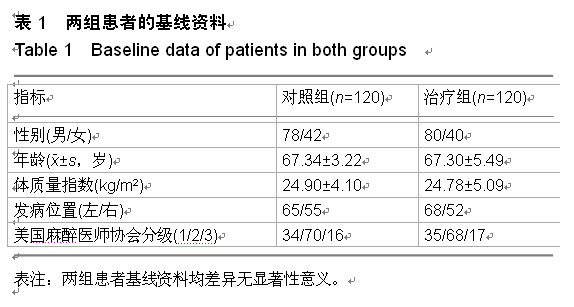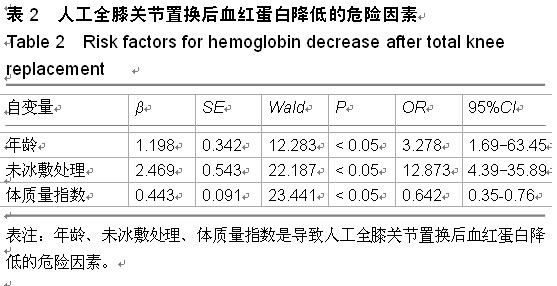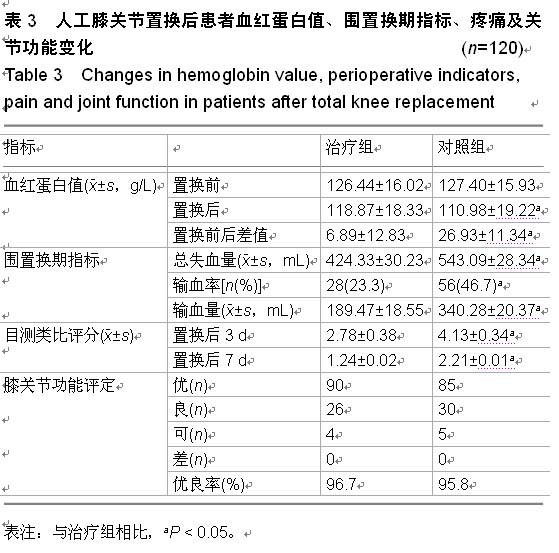| [1] Adie S, Naylor JM, Harris IA. Cryotherapy after total knee arthroplasty:a systematic review and meta-analysis of randomized controlled trials. J Arthroplasty. 2010;25(5): 709-715.
[2] 乔艳琴,蒋攀峰.持续冰敷对全膝关节置换后24 h出血量的影响[J].中国现代药物应用,2012,6(12):59-60.
[3] Alxelsson K, Gupta A, Johanzon E, et al. Intra-articular administration of ketorolac, morphine and ropivacaine combined witll intra-articular patient controlled regional analgesia for pain relief after shoulder surgery:a randomized, double-blind study. Anesth Analg. 2012;106(1):328-333.
[4] 谢琪,刘慧,黄华扬,等.持续脉冲加压冷疗对膝关节镜置换后早期功能障碍的影响[J].广东医学,2014,35(2):239-240.
[5] Kraus T, Heidari N, Martin F. Outcome of repaired unstable meniscal tears in children and adolescents. Acta orthopaedica. 2012;83(3):110-112.
[6] Wong J, Abrishami A, EI Beheiry H, et al. Topical application of tranexamic acid reduces postoperative blood loss in total knee arthroplasty: a randomized,controlled trial. J Bone Joint Surg Am. 2010;92(15):2503-2513.
[7] 范柳萍,李晓芳,黄房珍.膝关节镜置换后不同冰敷方法的效果比较[J].护理学报,2014,10(8):52-53.
[8] Ishida K, Tsumura N, Kitagawa A, et al. Intra-articular injection of tranexamic acid reduces not only blood loss but also knee joint swelling after total knee arthroplasty. Int Orthrop. 2011; 35(11):1639-1645.
[9] 张国妹,姚剑英,周玉娟,等.生物冰袋冷敷在全膝关节置换护理中的应用[J].广东医学,2011,32(19):2616-2617.
[10] Eum DS, Lee HK, Hwang SY, et al. Blood loss after navigation-assisted minimally invasive total knee arthroplasty. Orthopedics. 2013;29(10):152-157.
[11] 张洪敬,张琛.气压冰敷对小腿闭合性骨折患者置换后早期应用的效果观察[J].中国现代药物应用,2014,8(2):187-188.
[12] Shelton WR. Arthroscopic allograft surgery of the knee and shoulder: indications, techniques, and risks. Arthroscopy. 2003;19(Suppl 1):110-112.
[13] Thorey F, Stukenborg-Colsma C, Windhagen H, et al. The effect of tourniquet release timing on perioperative blood loss in simultaneous bilateral comented total knee arthroplasty:a prospective randomized study. Technol Health Care. 2008; 16(2):85-92.
[14] 李兴鑫,姚一民,陈一平,等.冰敷对Schatzkeer V型胫骨平台骨折置换后隐性失血及肿胀的影响[J].西南国防医药,2012,22(6): 626-627.
[15] Li B, Wen Y, Wu H, et al.The effect of tourniquet use on hidden blood loss in total Knee arthroplasty. Int Orthop. 2013; 33(5):1263-1268.
[16] Shen HL, Li Z, Feng ML, et al. Analysis on hidden blood loss of total knee arthroplasty in treating knee osteoarthritis. Chin Med J Engl. 2011;124(11):1653-1656.
[17] 王晓冬,姜媛媛,王建忠,等.地奥司明联合氨甲环酸治疗老年股骨转子间骨折置换后隐性失血的疗效分析[J].实用临床医药杂志, 2013,17(21):112-114.
[18] Jameson SS, Dowen P, James I, et al. The burden of arthroscopy of the knee: a contemporary analysis of data from the English NHS. J Bone Joint Surg. 2011;93(10):67-68.
[19] Meng S, Deng Q, Feng C, et al. Effects of massage treatment combined with topical cactus and aloe on puerperal milk stasis. Breast Dis. 2015.
[20] Batra G. Application of ice cube prior to subcutaneous injection of heparin in pain perception and ecchymosis of patients with cardiovascular problems. Nurs J India. 2014; 105(4):155-159.
[21] Soleymanifard F, Khademolhoseyni SM, Nouri JM. Nursing process in post tonsillectomy pain diagnosis: a systematic review. Glob J Health Sci. 2014;7(1):180-187.
[22] K?l?ç ?, Kaya F, Özdemir AT, et al. Nicolau syndrome due to diclofenac sodium (Voltaren®) injection: a case report. J Med Case Rep. 2014;8:404.
[23] Ozturk M, Mutlu F, Kara A, et al. Evaluation of the effect of nasal dorsal skin cooling on nasal mucosa by acoustic rhinometry. J Laryngol Otol. 2014;128(12):1067-1070.
[24] Taylor J, van de Ven R, Hopkins DL. SmartShape™ technology. Modifying the shape of the beef cuberoll and the consumer response to shaped scotch fillet steaks. Meat Sci. 2014;96(3):1125-1132.
[25] Bilkhu PS, Wolffsohn JS, Naroo SA, et al. Effectiveness of nonpharmacologic treatments for acute seasonal allergic conjunctivitis. Ophthalmology. 2014;121(1):72-78.
[26] Mayo TT, Khan F, Hunt C, et al. Comparative study on bruise reduction treatments after bruise induction using the pulsed dye laser. Dermatol Surg. 2013;39(10):1459-1464.
[27] Du G, Liu Y, Li J, et al. Hypothermic microenvironment plays a key role in tumor immune subversion. Int Immunopharmacol. 2013;17(2):245-253.
[28] Schmid AB, Coppieters MW, Ruitenberg MJ, et al. Local and remote immune-mediated inflammation after mild peripheral nerve compression in rats. J Neuropathol Exp Neurol. 2013; 72(7):662-680.
[29] Xuan X, Huang L, Pan X, et al. Simultaneous determination of five cold medicine ingredients in paracetamol triprolidine hydrochloride and pseudoephedrine hydrochloride tablets by pH/organic solvent double-gradient high performance liquid chromatography. Se Pu. 2013;31(2):133-138.
[30] Ortiz Tde A, Forti G, Volpe MS, et al. Experimental study on the efficiency and safety of the manual hyperinflation maneuver as a secretion clearance technique. J Bras Pneumol. 2013;39(2):205-213.
[31] Millard RP, Towle-Millard HA, Rankin DC, et al. Effect of cold compress application on tissue temperature in healthy dogs. Am J Vet Res. 2013;74(3):443-447.
[32] Ross JR, Matava MJ. Tattoo-induced skin "burn" during magnetic resonance imaging in a professional football player: a case report. Sports Health. 2011;3(5):431-434.
中国组织工程研究杂志出版内容重点:人工关节;骨植入物;脊柱;骨折;内固定;数字化骨科;组织工程
|




.jpg)